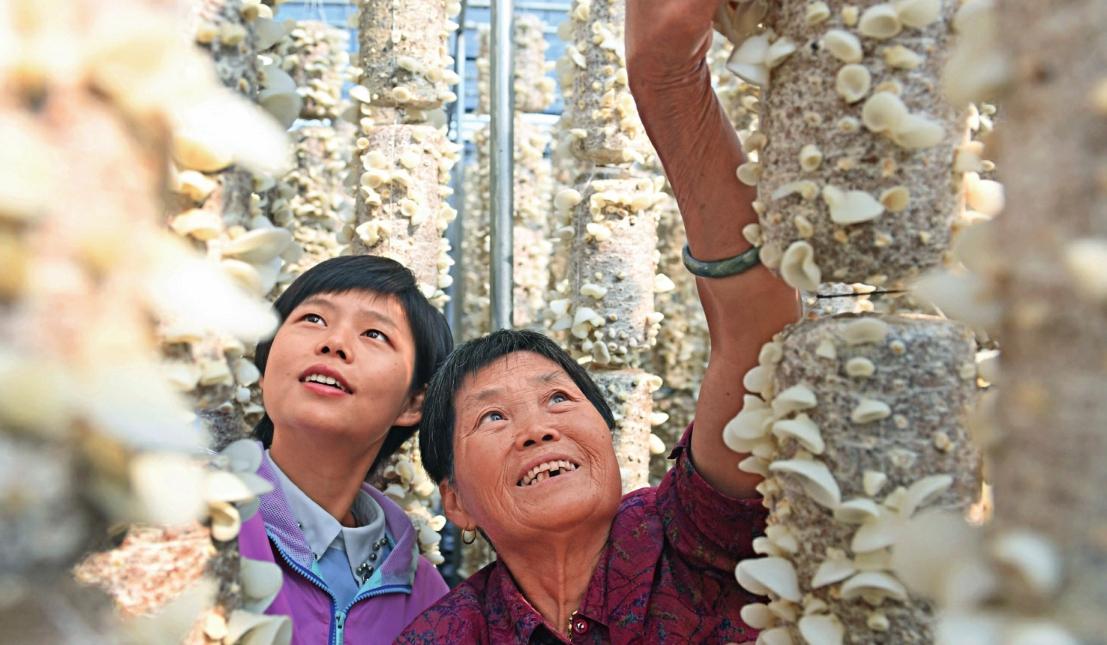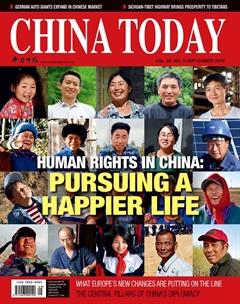China’s Human Rights Development Path Leads to a Bright Future
By ZHANG XIAOLING

ON March 15, 2019, the United Nations Hu- man Rights Council (UNHRC) adopted the report for Chinas Universal Periodic Review(UPR) in Geneva. At the meeting, representatives of more than 120 countries spoke in approval of the human rights situation in China, and thought highly of the remarkable achievements the country has made on the human rights front. They agreed that its progress in poverty reduction and protection of citizens economic, social, and cultural rights is of great significance, and is an important contribution to the common development of the world.
Last September, I attended the Beijing Forum on Human Rights, which was themed “Poverty Elimination: Seeking Common Development to Build a Community of a Shared Future for Mankind.” During the event, officials, scholars, and prominent figures from nearly 50 countries and regions confirmed and commended the human rights situation in China.
Tom Zwart, professor of law of Utrecht University and director of the Cross-cultural Human Rights Center of Vrije Universiteit Amsterdam, said at the forum that Chinas achievements in reducing poverty are its largest contribution to the global human rights cause. Devarayapuram Ramasamy Kaarthikeyan, president of Age Care India, said in his speech that China set an example for the rest of the world by planning to wipe out poverty by 2020. Neil Forbes Davidson, parliamentarian of the House of Lords of the U.K., lauded Chinas poverty reduction program as the most successful in the world and its scale of poverty reduction unprecedented globally, which has not only changed China but the entire world.
Chinas population of 1.4 billion accounts for 18.4 percent of the worlds total. Enabling them to stay free of poverty speaks volumes about the development of human rights in China.
Peerless Feat in Poverty Reduction
Since the founding of the Peoples Republic of China (PRC) in 1949, especially since the start of reform and opening-up in 1978, China has lifted more than 700 million people out of absolute poverty. During the four decades from 1978 to 2018, China slashed its incidence of poverty from 97.5 percent to just 1.7 percent. Since 2012, the central leadership with President Xi Jinping at the core has implemented a targeted poverty alleviation strategy, which has helped more than 10 million people shake off poverty every year. The number of people being freed from the shackles of poverty in China is the largest worldwide. The country is also the first to achieve the UN Millennium Development Goals.
Creating a Better Life for Chinese People
Before the founding of the PRC, as many as 80 percent of Chinese people were starved or semi-starved year round, and tens of thousands to hundreds of thousands died of hunger every year. In 1949, Chinas per capita gross national income (GNI) was a mere US $27, and average life expectancy only 35 years, while the mortality rate hovered at 33 per mille, and up to 80 percent of the population were illiterate.
Since the founding of the PRC, Chinas Human Development Index (HDI) has been improving by leaps and bounds. Last year, Chinas per capita GNI was close to US $10,000, putting it above the average level of upper middle-income countries; its average life expectancy exceeded 76 years, on par with the level of moderately developed countries; people aged 15 and older received 9.6 years of education on average, with those of working ages receiving 10.5 years of education; the completion rate of compulsory education was at 93.8 percent; and the availability of compulsory education has reached the average level of high-income countries. China has achieved historic leaps from poverty to secure access to food and clothing, and is now on the way to attain moderate prosperity.
Ensuring the Rights of Special Groups
Over the past 70 years, China has formulated a slew of laws to protect the rights of ethnic minority groups, women, children, senior citizens, and the disabled. Since 2009 it has promulgated three National Human Rights Action Plans, all stipulating in detail the requirements and measures to protect the rights of specific groups.

To take the example of women, in old times women were under the oppression of feudalism, theocracy, clanism, and patriarchy, and had no equal rights or opportunities. This oppression and discrimination against them was shattered after the founding of the PRC, which enshrines in its Constitution the principle of gender equality. In 1995, China hosted the fourth United Nations World Conference on Women.
With gender equality as a basic state policy, China has steadfastly improved the legal system to protect the rights and interests of women, included their development into the overall plan for national economic and social development, and implemented specific programs for womens development. These have effectively boosted womens rights in all regards, including politics, economy, culture, and social life.
Female participation in politics has increased steadily. Last year 742 women were elected into the National Peoples Congress, taking up 24.9 percent of the seats. In 2017, there were 1.9 million women (26.5 percent of the total staff) working for Party and government bodies across the country, compared with 422,000 in the early years of reform and opening-up. Women account for more than 43 percent of Chinas employed population. The gap in education between men and women is closing.
Women are also fully enjoying the right to life and health. Womens average life expectancy now stands at 79.4 years. Last year, the mortality rate of women in pregnancy and childbirth fell to 18.3 per 100,000 people, and infant mortality rate to 6.1 per 1,000. The core health indexes of Chinese women and children are in general at the level of upper-middle-income countries. The World Health Organization lists China as one of the 10 countries with high performance in maternal and child health.

Sharing Its Experience with the World
To date, China has signed 26 international human rights agreements. It was one of the major promoters of the Declaration on the Right to Development, and proposed the Convention on the Rights of Persons with Disabilities. It has been elected a UNHRC member for four terms.
In March 2017, the concept of building a community of shared future for humankind, the brainchild of Chinese President Xi Jinping, was written into two UNHRC resolutions. In March 2018, a resolution China proposed, Promoting Mutually Beneficial Cooperation in the Field of Human Rights, was adopted by the 37th session of UNHRC. In September 2018, Chinas envoy delivered a statement on behalf of 140 countries – Working Together to Eliminate Poverty and Promoting the International Human Rights Cause – at the 39th session of the UNHRC. In November of the same year, China promised a donation of US $800,000 every year to the UN Human Rights Office of the High Commissioner in the next five years to support its work. China has also established the Assistance Fund for South-South Cooperation to help other developing countries shake off poverty.
Looking back at the past 70 years, we can see that China, the largest developing country in the world, has integrated the principle of universality of human rights with Chinas national conditions to make constant innovations in human rights development. It focuses on the right to subsistence and development, a basic human right, sees development as the key to solving all problems facing China, and has opened a new path of human rights development that has distinctive Chinese characteristics. Chinas human rights programs and practices are inspirations for other developing countries, and can be borrowed by the international community in tackling challenges to human rights.
- CHINA TODAY的其它文章
- Expectations for Future China-U.S.Relations
- Xi Jinping Holds Talks with President Iván Duque Márquez of Colombia
- China Releases White Paper on People with Disabilities
- Foreign Trade Grows Steadily with Increase of Internal Drivers of Growth
- EU-China Youth Music & Art Festival Held in Belgium
- Reflections on Hong Kong

